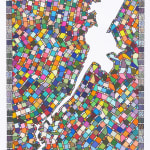





Lordy Rodriguez Filipino, b. 1976
Texas 35th, 2020
ink on paper
44 x 26 in
111.8 x 66 cm
111.8 x 66 cm
Further images
Texas's 35th congressional district is a new district that was created as a result of the 2010 Census. The shape of the district has been described as one of the...
Texas's 35th congressional district is a new district that was created as a result of the 2010 Census. The shape of the district has been described as one of the ten most gerrymandered in the US. This district includes parts of the San Antonio metropolitan area (primarily Black-and Hispanic-majority areas), including portions of Bexar County, thin strips of Comal and Hays, and a portion of Caldwell county, as well as portions of southern and eastern Austin in Travis County.
In March 2017, a panel of federal judges ruled that the 35th district was illegally drawn with discriminatory intent. In August 2017 there was another ruling that the district is unconstitutional. However, the district was allowed to stand in the Supreme Court's 2018 Abbott v. Perez ruling.
In this piece, the shape of the district is emphasized by its lack of color. The grid of the map is defined by the shape of the district, as an indication that everyone is affected by gerrymandering, even those populations in neighboring districts. These polygonal shapes also resemble rural plots of land. Around the border, rather than within the piece itself, Lordy uses the language of freeways, each one randomly assigned a fluorescent color, with one single road connecting the entire border. Inside of the border, Lordy removed all the earth tones and black/white/gray tones from the group of colors subject to randomization. Lordy wanted the border to be completely separate from the interior of the piece, both in terms of color and forms, to further emphasize the idea of polarity.
In March 2017, a panel of federal judges ruled that the 35th district was illegally drawn with discriminatory intent. In August 2017 there was another ruling that the district is unconstitutional. However, the district was allowed to stand in the Supreme Court's 2018 Abbott v. Perez ruling.
In this piece, the shape of the district is emphasized by its lack of color. The grid of the map is defined by the shape of the district, as an indication that everyone is affected by gerrymandering, even those populations in neighboring districts. These polygonal shapes also resemble rural plots of land. Around the border, rather than within the piece itself, Lordy uses the language of freeways, each one randomly assigned a fluorescent color, with one single road connecting the entire border. Inside of the border, Lordy removed all the earth tones and black/white/gray tones from the group of colors subject to randomization. Lordy wanted the border to be completely separate from the interior of the piece, both in terms of color and forms, to further emphasize the idea of polarity.
Exhibitions
Artpace, San Antonio, Texas, Since Last We Last Met, Jan 12 – Jun 4, 202311
of
11





